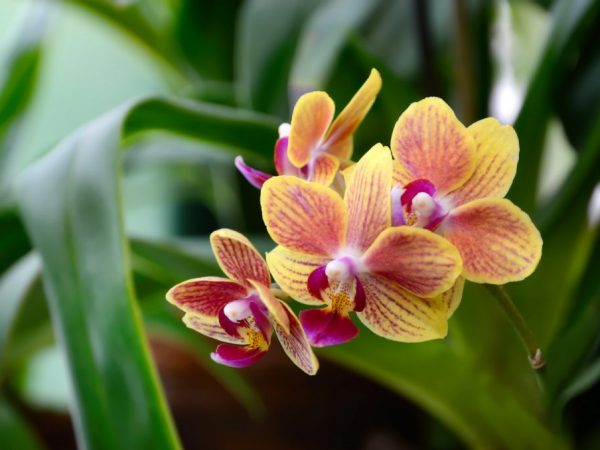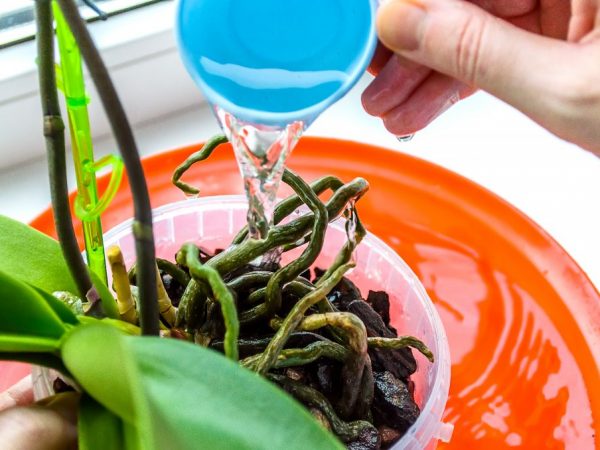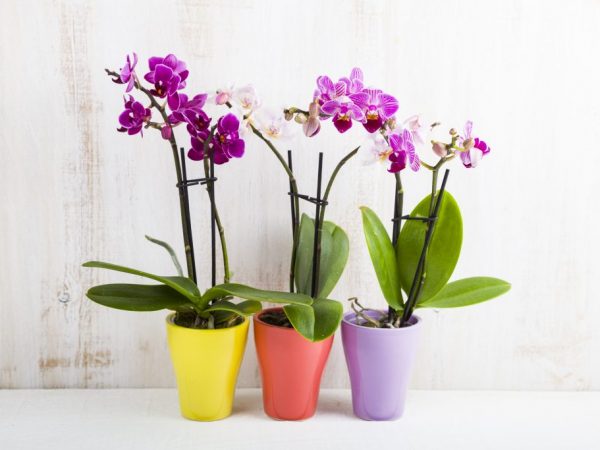The use of hydrogen peroxide for orchids
Hydrogen peroxide for orchids is used as a means of treating and preventing plants from diseases. Watering with such a solution provides leaves and roots with full oxygen saturation, which ordinary water cannot provide.

The use of hydrogen peroxide for orchids
Benefits of hydrogen peroxide
The use of hydrogen peroxide (H2O2) includes a number of areas: medicine, beauty industry.
On contact with water, peroxide decomposes into water and oxygen, is an environmentally friendly substance and does not harm the environment. The use of peroxide - a solution of hydrogen peroxide and water - has an effect on the flower and the soil, similar to the effect of rainwater. After the rain, all plants come to life, bloom magnificently, heal from diseases and get rid of pests.
Exposure to hydrogen peroxide
Watering decorative orchids with hydrogen peroxide is useful in that:
- kills pests and heals the plant;
- fertilizes the substrate;
- accelerates the growth of flowers;
- acts as a fungicide;
- saturates the soil with oxygen
- strengthens small roots
For indoor plants, peroxide is used as a means of combating diseases or pests.
At first, water and spray the plant with care. In the process of processing phalaenopsis, other fertilizers are not used in order to avoid an undesirable reaction.

Watering decorative orchids with hydrogen peroxide is beneficial
Watering flowers with hydrogen peroxide
Hydrogen peroxide is used already at the first stage - the stage of processing orchid seeds before planting. It oxygenates the seeds, strengthening them and stimulating growth. The use of the product has a beneficial effect on the flower.
Soaking seeds in hydrogen peroxide
To soak the seeds you will need:
- 3% hydrogen peroxide - 25 drops;
- water - 250 ml.
The seeds are soaked in the resulting solution, after 30 minutes they are removed and washed with water.
Watering flowers with hydrogen peroxide
Usually, settled water from the tap is used for irrigation. Plants love and need natural watering, it is provided by rainwater or the same peroxide solution. It contains all the required set of trace elements for proper development and growth.
Before use, the product must be diluted with water so as not to harm the sensitive orchid leaves. For this, 2 tbsp. l. the funds are mixed with 1 liter of water. Phalaenopsis should be watered and sprayed with such a solution all year round, but not more often than once a week. Peroxide stimulates the growth of orchids.
It is advisable to spray and water the flowers in a well-ventilated area.
To improve air permeability in 1 liter of water, dilute 2 tbsp. l. 3% hydrogen peroxide. Watering is carried out 2 times a week, alternating with liquid phosphorus fertilizers.

Spray and water the flowers, preferably in a well-ventilated area.
Hydrogen peroxide for disease
In case of damage by pests and bacterial infections, a standard solution is prepared: 250 ml of water per 30 ml of the product, 40 drops of iodine are added to it. By treating with such a solution, the gardener protects the orchid from spider mites, scale insects, small midges and mealy worms. Watering and spraying should be done several times.
If the pest infestation is large, rubbing alcohol is added to the solution before spraying. After a week, watering and spraying is repeated to consolidate the result.
When a flower is affected by fungal diseases: mold, root rot, add alcohol and 2 tbsp to the standard solution. soap shavings. Such a solution disinfects the affected areas and has an aeration effect on the substrate.
Use as fertilizer
Hydrogen peroxide provides the orchid with all the necessary trace elements. When using it, there is no need for additional fertilizers. Over-saturation with peroxide pampers the plant, thereby complicating further care.
Conclusion
Oxygen, which is part of hydrogen peroxide, has a destructive effect on microbes, spores and pests, which protects flowers. Also, oxygen saturates the soil, provoking the rapid growth of the flower. Hydrogen peroxide is used to purify irrigation water and even remove pesticides.


